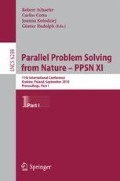Abstract
The property that neighbouring genotypes tend to map to neighbouring phenotypes, i.e. locality, is an important criterion in the study of problem difficulty. Locality is problematic in tree-based genetic programming (GP), since typically there is no explicit phenotype. Here, we define multiple phenotypes for the artificial ant problem, and use them to describe a novel fine-grained view of GP locality. This allows us to identify the mapping from an ant’s behavioural phenotype to its concrete path as being inherently non-local, and show that therefore alternative genetic encodings and operators cannot make the problem easy. We relate this to the results of evolutionary runs.
Access this chapter
Tax calculation will be finalised at checkout
Purchases are for personal use only
Preview
Unable to display preview. Download preview PDF.
References
Miller, J.F., Thomson, P.: Cartesian genetic programming. In: Poli, R., Banzhaf, W., Langdon, W.B., Miller, J., Nordin, P., Fogarty, T.C. (eds.) EuroGP 2000. LNCS, vol. 1802, pp. 121–132. Springer, Heidelberg (2000)
Brameier, M., Banzhaf, W.: Linear genetic programming. Springer, New York (2006)
O’Neill, M., Ryan, C., Keijzer, M., Cattolico, M.: Crossover in grammatical evolution. Genetic Programming and Evolvable Machines 4(1), 67–93 (2003)
Rothlauf, F.: Representations for Genetic and Evolutionary Algorithms, 2nd edn. Physica-Verlag (2006)
Langdon, W.B., Poli, R.: Why ants are hard. In: Koza, J.R. (ed.) Proceedings of the Third Annual Conference on Genetic Programming, pp. 193–201. Morgan Kaufmann, Madison (1998)
Galván-Lopéz, E., McDermott, J., O’Neill, M., Brabazon, A.: Towards an understanding of locality in genetic programming. In: GECCO 2010: Proceedings of the 12th Annual Conference on Genetic and Evolutionary Computation, Portland, Oregon, USA. ACM Press, New York (2010)
Galván-Lopéz, E., McDermott, J., O’Neill, M., Brabazon, A.: Defining locality in genetic programming to predict performance. In: CEC 2010: Proceedings of the 12th Annual Congress on Evolutionary Computation, Barcelona, Spain. IEEE Press, Los Alamitos (2010)
Beadle, L., Johnson, C.G.: Semantic analysis of program initialisation in genetic programming. Genetic Programming and Evolvable Machines 10(3), 307–337 (2009)
Beadle, L., Johnson, C.G.: Semantically driven mutation in genetic programming. In: Proceedings of IEEE Congress on Evolutionary Computing, pp. 1336–1342 (2009)
Nguyen, Q.U., Nguyen, X.H., O’Neill, M.: Semantic aware crossover for genetic programming: The case for real-valued function regression. In: Proceedings of the 12th European Conference on Genetic Programming, pp. 292–302. Springer, Heidelberg (2009)
Jackson, D.: Phenotypic diversity in initial genetic programming populations. In: Esparcia-Alcázar, A.I., Ekárt, A., Silva, S., Dignum, S., Uyar, A.Ş. (eds.) EuroGP 2010. LNCS, vol. 6021, pp. 98–109. Springer, Heidelberg (2010)
Hordijk, W.: A measure of landscape. Evolutionary Computation 4(4), 335–360 (1996)
Altenberg, L.: NK fitness landscapes. In: Bäck, T., Fogel, D.B., Michalewicz, Z. (eds.) Handbook of Evolutionary Computation. IOP Publishing Ltd./Oxford University Press (1997)
Jones, T.: Evolutionary Algorithms, Fitness Landscapes and Search. PhD thesis, University of New Mexico, Albuquerque (1995)
Vanneschi, L., Tomassini, M., Collard, P., Verel, S., Pirola, Y., Mauri, G.: A comprehensive view of fitness landscapes with neutrality and fitness clouds. In: Ebner, M., O’Neill, M., Ekárt, A., Vanneschi, L., Esparcia-Alcázar, A.I. (eds.) EuroGP 2007. LNCS, vol. 4445, pp. 241–250. Springer, Heidelberg (2007)
Poli, R., Vanneschi, L.: Fitness-proportional negative slope coefficient as a hardness measure for genetic algorithms. In: Proceedings of GECCO 2007, London, UK, pp. 1335–1342 (2007)
Altenberg, L.: Fitness distance correlation analysis: An instructive counterexample. In: Proceedings of the Seventh International Conference on Genetic Algorithms, pp. 57–64 (1997)
Vanneschi, L., Valsecchi, A., Poli, R.: Limitations of the fitness-proportional negative slope coefficient as a difficulty measure. In: Proceedings of the 11th Annual conference on genetic and evolutionary computation, pp. 1877–1878. ACM, New York (2009)
Jansen, T.: On classifications of fitness functions. In: Theoretical aspects of evolutionary computing, pp. 371–386. Springer, Heidelberg (2001)
Rothlauf, F., Oetzel, M.: On the locality of grammatical evolution. In: Collet, P., Tomassini, M., Ebner, M., Gustafson, S., Ekárt, A. (eds.) EuroGP 2006. LNCS, vol. 3905, pp. 320–330. Springer, Heidelberg (2006)
Dawkins, R.: The Extended Phenotype. Oxford University Press, Oxford (1982)
Koza, J.R.: Genetic Programming: On the Programming of Computers by Means of Natural Selection. The MIT Press, Cambridge (1992)
Bryant, R.: Symbolic Boolean manipulation with ordered binary-decision diagrams. ACM Computing Surveys (CSUR) 24(3), 318 (1992)
Gomez, F.J.: Sustaining diversity using behavioral information distance. In: Proceedings of the 11th Annual conference on Genetic and evolutionary computation, Montréal, Canada, pp. 113–120. ACM, New York (2009)
Tomassini, M., Vanneschi, L., Collard, P., Clergue, M.: A study of fitness distance correlation as a difficulty measure in genetic programming. Evolutionary Computation 13(2), 213–239 (2005)
Author information
Authors and Affiliations
Editor information
Editors and Affiliations
Rights and permissions
Copyright information
© 2010 Springer-Verlag Berlin Heidelberg
About this paper
Cite this paper
McDermott, J., Galván-Lopéz, E., O’Neill, M. (2010). A Fine-Grained View of GP Locality with Binary Decision Diagrams as Ant Phenotypes. In: Schaefer, R., Cotta, C., Kołodziej, J., Rudolph, G. (eds) Parallel Problem Solving from Nature, PPSN XI. PPSN 2010. Lecture Notes in Computer Science, vol 6238. Springer, Berlin, Heidelberg. https://doi.org/10.1007/978-3-642-15844-5_17
Download citation
DOI: https://doi.org/10.1007/978-3-642-15844-5_17
Publisher Name: Springer, Berlin, Heidelberg
Print ISBN: 978-3-642-15843-8
Online ISBN: 978-3-642-15844-5
eBook Packages: Computer ScienceComputer Science (R0)

